sport mode AUDI A4 AVANT 2008 Owners Manual
[x] Cancel search | Manufacturer: AUDI, Model Year: 2008, Model line: A4 AVANT, Model: AUDI A4 AVANT 2008Pages: 368, PDF Size: 46.19 MB
Page 148 of 368
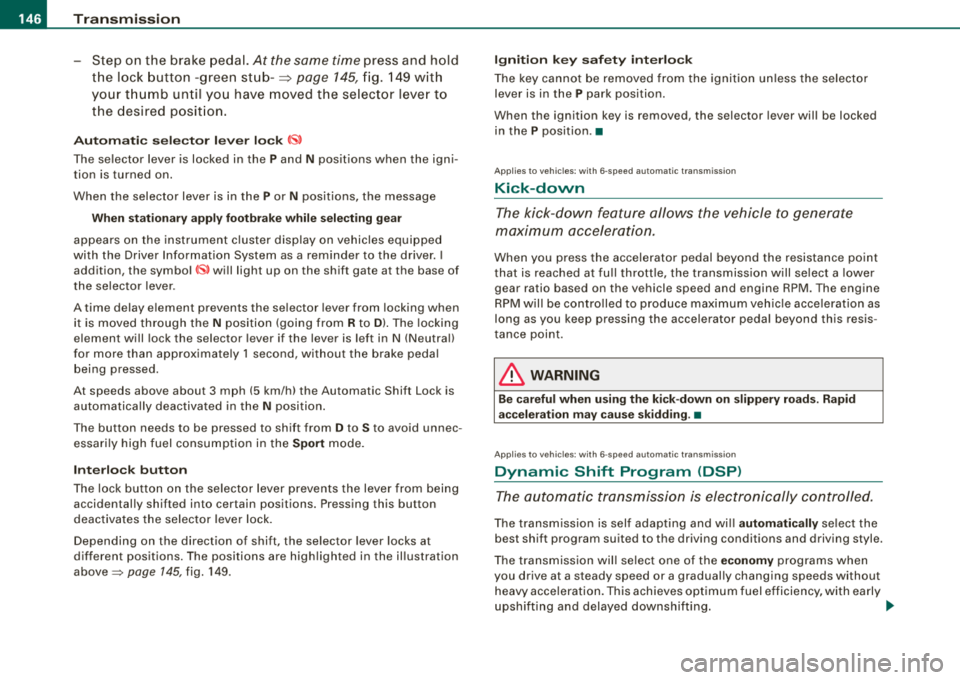
___ T
_ r_a _ n_ s_m _ i_s _s _i_o _n ______________________________________________________ _
- Step on the brake pedal. At the same time press and hold
the lock button -green
st ub-=> page 145, fig. 1 49 w it h
your t humb until you have moved the se lector leve r to
the desired posit ion.
Au toma tic selec tor le ver lo ck (IS,
The se lector lever is locked in the P and N positions when the igni
t io n is turned on .
When the selector lever is in the
P or N positions, the message
When station ary app ly footbr ake while sele ct ing ge ar
appears on the instrument c luster display on vehicles equipped
with the Driver Information System as a reminder to the driver. I
addition, the symbo l
53 will light up on the shift gate at the base of
the selector lever.
A time delay e lement prevents the se lector lever from locking when
it is moved through the
N position (going from R to D ). The locking
element will lock the selector lever if the lever is left in N (Neutral)
for more than approximate ly 1 seco nd, without the brake peda l
being pressed.
At speeds above about 3 mph (5 km/h) the Automatic Shift Lock is automatically deactivated in the
N position .
The button needs to be pressed to shift from
D to S to avoid unnec
essari ly high fuel consump tion in the
Sport mode.
Int erlock button
The lock button on t he se lector lever preve nts the lever from bei ng
accidentally shifted into certain positions. Pressing this button
deactivates the selector leve r lock.
Depending on the direction of shift, the se lector lever locks at
different positions. The positions are highlighted in the il lustration
above~ page 145, fig. 149 .
Ignition ke y sa fe ty int erlo ck
The key cannot be removed from the ignition un less the selector
lever is in the P park position.
When the ignition key is removed, the selector lever will be locked
i n the
P position. •
Applies to vehicles : with 6-speed automatic transmiss ion
Kick-down
T he kick-down feature allows the vehicle to generate
maximum acceleration.
When you press the accelerator pedal beyond the resistance point
that is reached at fu ll thrott le, the transmiss ion w ill se lect a lower
gear ratio based on the vehicle speed and engine RPM . T he engine
RPM w ill be contro lled to produce maximum veh ic le acce leration as
long as you keep pressing the accelerator peda l beyond this resis
t ance point.
& WARNING
Be c are ful when u sing the ki ck-down on slippery ro ads. R apid
a cc elerat ion m ay ca use skidd ing .
•
Ap plies t o vehic les : with 6-s pee d auto mat ic tran smi ssi on
Dynamic Shift Program (DSP)
The automatic transmission is electronically controlled.
The transm ission is self adapting and wi ll automatically se lect the
best shift program suited to the driving conditions and driving style.
The transmission wil l se lect one of the
e conomy programs when
you drive at a steady speed or a gradually changing speeds without heavy acce leration. This achieves optimum fuel efficiency, with early
upshifting and delayed downshifting.
~
Page 226 of 368
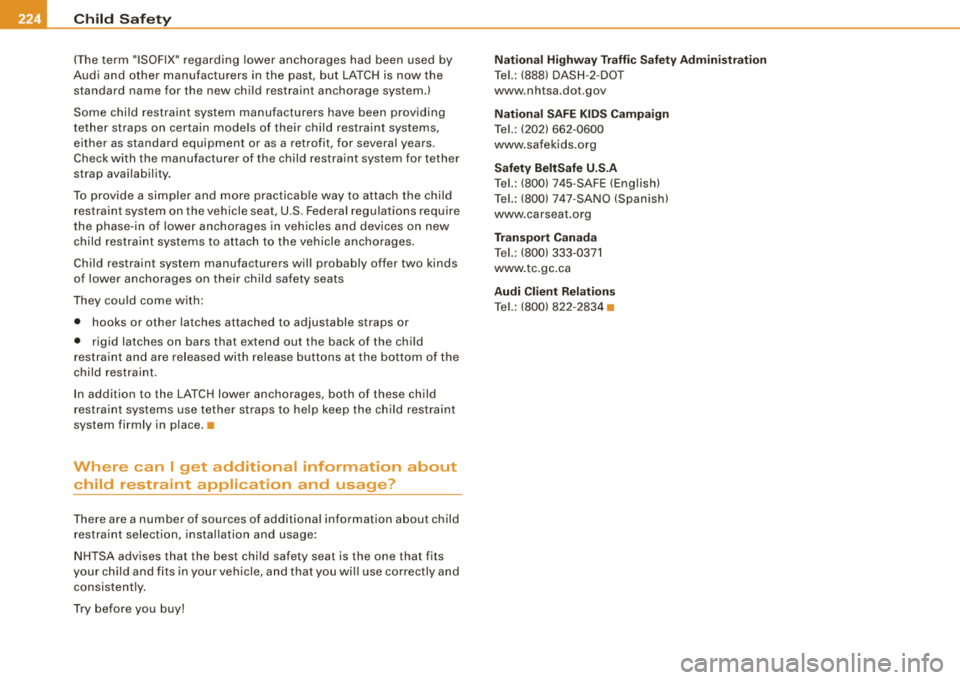
___ C_h_ i_ld _ S_ a_ f_ e_ t--= y'-------------------------------------------------
(The term " ISOFIX" regarding lower anchorages had been used by
Audi and other man ufacturers in the pas t, but LATC H is now the
standard name for the new child restraint anchorage system.)
Some chi ld restraint system manufacture rs have been providing
tet her straps on certain mode ls of their child restra int systems ,
either as standard equipment or as a retrofit, for several years .
Chec k w ith the manu factu rer o f th e ch ild restra int syste m for tether
strap avai labili ty .
T o provide a simpler and more practicab le way to attach the child
restraint system on the vehicle seat, U .S . Federal regulations require
t he phase -in of lowe r ancho rages in vehicles and devices on new
child restraint systems to attach to the veh icle anchorages.
Ch ild restraint system manufacturers will probably offer two k inds
o f lower a nchorages on their child safety seats
T hey cou ld come with :
• hooks or ot her latches attached to adjustable st raps or
• rigid latches on bars that extend out the back of the ch ild
r est raint and are re leased w ith release but tons a t the bottom of the
child restra int.
I n addition to the LA TCH lower anchorages, both of these child
r estra int syst ems use tether straps to help keep the c hild restraint
system firmly in p lace .
•
Where can I get additional information about
child restraint application and usage?
T here are a n umbe r of so urces of additional info rma tion abo ut child
r estra int selection, i nsta llat io n and usage :
NH TSA advises that the best chi ld safety seat is the one that fits
your c hild and f its in your ve hicle, a nd that y ou will u se c orrectly and
consistent ly.
T ry befo re you buy! National Highway Traffic Safety Administration
Tel. : (888) DAS H-2 -DOT
www.nhtsa .dot .gov
Nation al SAFE KIDS Camp aign
Tel.: (202) 662 -0600
www .sa fek ids.org
Safety BeltSafe U .S .A
T el.:
(800! 745 -SAFE (Eng lish)
Tel. : (800) 7 47-SANO (S pan is h )
www.carseat.org
Transport Canada
T el. : (800) 333 -037 1
www .tc.gc.ca
Audi Client Relations
Tel. : (80 0) 82 2-2834
•
Page 247 of 368
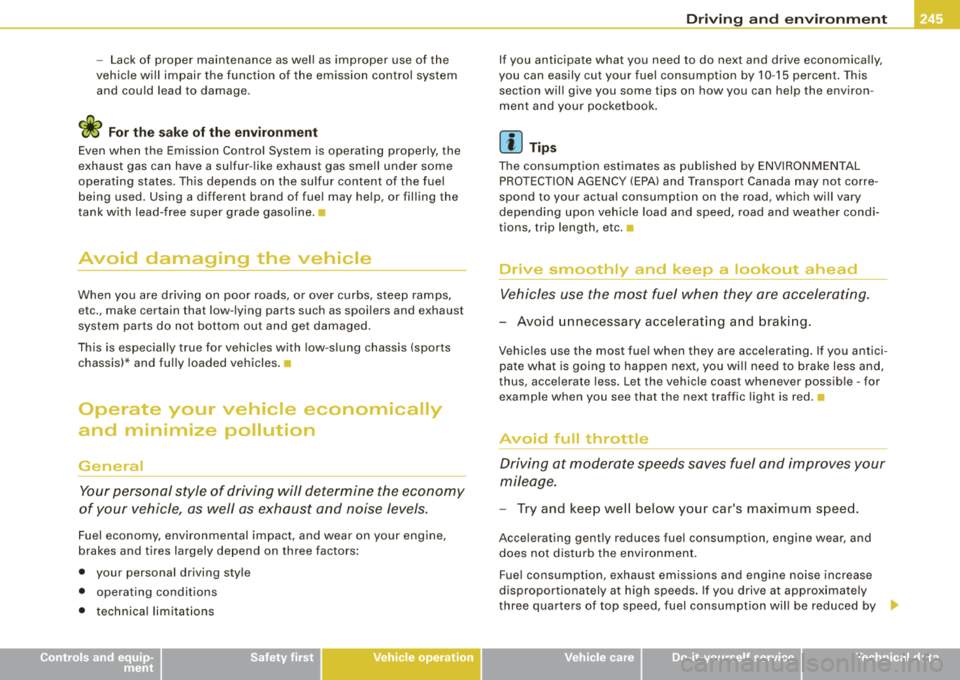
______________________________________________ D_ ri_v _ i_ n _, g..,_ a_ n_d _ e_ n_ v_i_r o_ n_m_ e_ n_t _____ ffllll
- Lack of proper maintenance as wel l as improper use of the
vehic le wi ll impair the func tion of the emission control system
and cou ld lead to damage .
<£> For the sake of the envir onm ent
Even when the Emission Control System is operating properly, the
exhaust gas can have a su lfur -like exhaust gas sme ll under some
operat ing states . Th is depends on the sulfur content of the fuel
being used. Using a different brand of fue l may he lp, or fil ling the
tank with lead -free super grade gasol ine. •
Avoid damaging the vehicle
When you are driving on poor roads, or over curbs, steep ramps,
e tc., make certain that low- lying parts such as spoilers and exhaust
system parts do not bottom out and get damaged.
This is especial ly true for vehicles with low -s lung chassis (sports
chassis)* and ful ly loaded vehicles .•
Operate your vehicle economically
and minimize pollution
General
Y o ur personal style of driving will determine the economy
of your vehicle, as well as exhaust and noise levels.
Fuel economy, env ironmental impact, and wear on your engine,
brakes and t ires largely depend on three factors :
• your personal driving sty le
• operat ing cond it ions
• technica l limitat ions
Controls and equip
ment Safety first Vehicle operation
If you anticipate what you need to do next and drive economica
lly,
you can easily cut your fuel consumptio n by 10 -15 percent . This
section wil l give you some tips on how you can help the environ
ment and your pocketboo k.
[ i ] Tips
The cons umption estimates as pub lished by ENV IRO NM EN TAL
PRO TECTION AGENCY (EPA) and Transport Canada may not corre
spond to your actua l consumption on the road, which wi ll vary
depending upon veh icle load and speed, road and weather condi
tions, trip length, etc. •
Drive smoothly and keep a lookout ahead
Vehicles use the most fuel when they ore accelerating .
-Avoid unnecess ary accelerating and brak ing.
Vehic les use the most fue l when they are accelerating . If you ant ici
pate what is going to happen ne xt, you wi ll need to brake less and,
thus , acce lerate less. Let the vehicle coast whenever poss ib le -for
examp le when you see that the next traffic light is red. •
Avoid full throttle
Driving at moderate speeds saves fuel and improves your
mileage.
- Try and keep we ll below your car 's max imum speed.
Acce lerating gent ly reduces fue l consump tion , engine wear, and
does no t disturb the environme nt.
Fue l consumption, exhaust emissions and engine noise increase
disproportionately at h ig h speeds . If you drive at approx imate ly
three quarters of top speed, fuel consumpt ion wil l be reduced by _,,,
Vehicle care Do-it-yourself service Technical data
Page 300 of 368
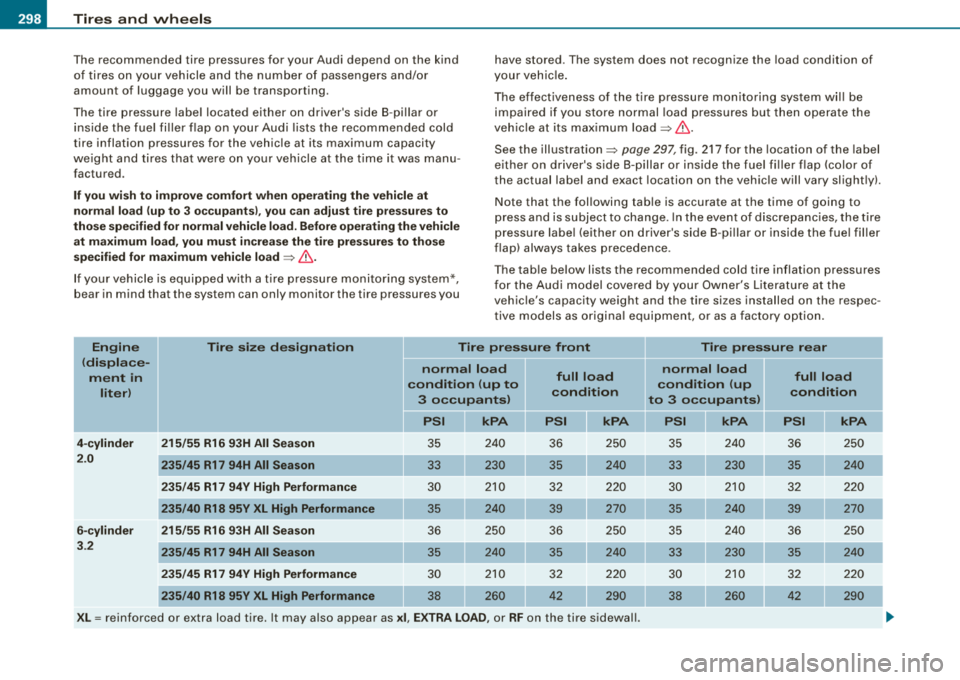
___ T_ ir_e _ s_ a_ n
_ d_ w_ h_ e_ e_ls _________________________________________________ _
The recommended tire pressures for your Audi depend on the kind
of tires on your vehicle and the number of passengers and/or
amount of luggage you will be transporting.
The tire pressure label located either on driver's side 8-pillar or
inside the fuel filler flap on your Audi lists the recommended cold
tire inflation pressures for the vehicle at its maximum capacity
weight and tires that were on your vehicle at the time it was manu
fac tured .
If you wish to improve comfort when operating the vehicle at
normal load (up to 3 occupants), you can adjust tire pressures to
those specified for normal vehicle load. Before operating the vehicle at maximum load, you must increase the tire pressures to those
specified for maximum vehicle load
~ & .
If your vehicle is equipped with a tire pressure monitoring system*,
bear in mind that the system can only monitor the tire pressures you have stored
. The system does not recognize the load condition of
your vehicle.
The effectiveness of the tire pressure monitoring system will be
impaired if you store normal load pressures but then operate the
vehicle at its maximum
load~& .
See the illustration~ page 297, fig . 217 for the location of the label
either on driver's side 8-pillar or inside the fuel filler flap (color of
the actual label and exact location on the vehicle will vary slightly).
Note that the following table is accurate at the time of going to
press and is subject to change . In the event of discrepancies, the tire
pressure label (e ither on driver's side 8 -pillar or inside the fuel filler
flap) always takes precedence.
The table below lists the recommended cold tire inflation pressures
for the Audi model covered by your Owner's Literature at the
vehicle's capacity weight and the tire si zes installed on the respec
tive models as original equipment, or as a factory option.
Engine Tire size designation Tire pressure front Tire pressure rear
(displace- normal load normal load
ment in condition (up to full load
condition (up full load
liter) condition
condition
3 occupants) to 3 occupants)
PSI kPA PSI kPA PSI kPA PSI kPA
4-cylinder 215/55 R16 93H All Season 35 240
36 250 35 240
36 250
2.0
235/45 R17 94H All Season 33 230 35 240 33 230 35 240
235/45 R17 94V High Performance 30 210
32 220 30 210
32 220
235/40 R18 95V XL High Performance 35 240 39 270 35 240 39 270
6-cylinder 215/55 R16 93H All Season 36 250 36 250 35 240 36 250
3.2
235/45 R17 94H All Season 35 240
35 240
33 230 35 240
235/45 R17 94V High Performance 30
210 32 220 30 210 32 220
235/40 R18 95V XL High Performance 38 260 42 290 38 260 42 290
XL = reinforced or extra load tire. It may also appear as xi, EXTRA LOAID, or RF on the tire sidewall.
Page 301 of 368
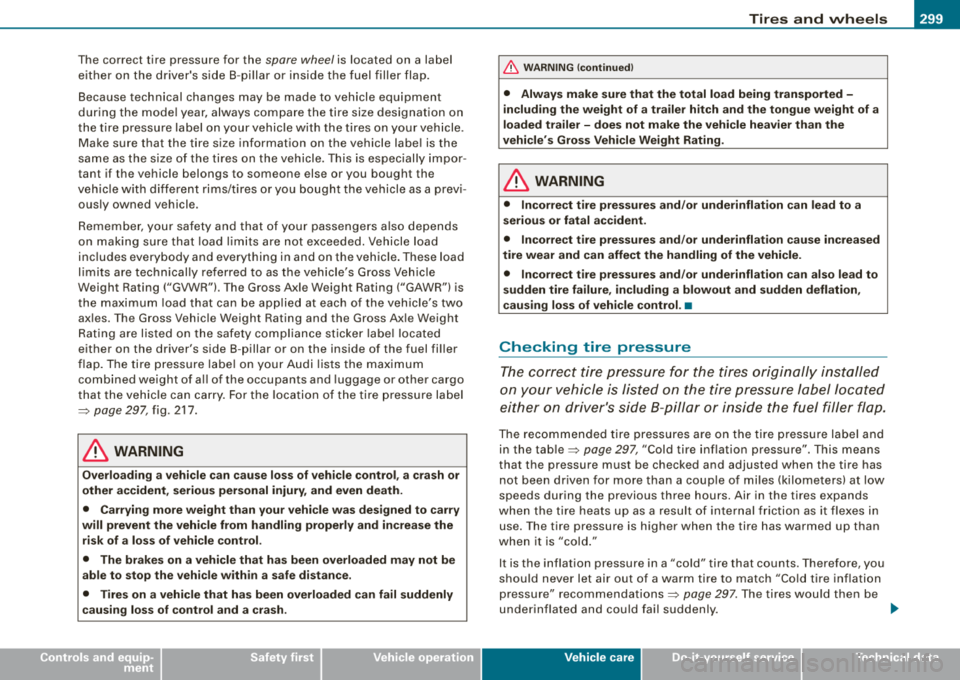
________________________________________________ T_ i
_ r_e _s_ a_n_ d_ w_ h_ e_e _ l_s __ fflll
The correct tire pressure for the spore wheel is located on a label
either on the driver's side B-pillar or inside the fuel filler flap.
Because technical changes may be made to vehicle equipment
during the model year, always compare the tire size designation on
the tire pressure label on your vehicle with the tires on your vehicle.
Make sure that the tire size information on the vehicle label is the
same as the size of the tires on the vehicle. This is especially impor
tant if the vehicle belongs to someone else or you bought the
vehicle with different rims/tires or you bought the vehicle as a previ
ously owned vehicle .
Remember, your safety and that of your passengers also depends
on making sure that load limits are not exceeded. Vehicle load
includes everybody and everything in and on the vehicle. These load
limits are technically referred to as the vehicle's Gross Vehicle
Weight Rating ("GVWR"l. The Gross Axle Weight Rating ("GAWR"l is
the maximum load that can be applied at each of the vehicle's two
axles. The Gross Vehicle Weight Rating and the Gross Axle Weight
Rating are listed on the safety compliance sticker label located
either on the driver's side B-pillar or on the inside of the fuel filler
flap. The tire pressure label on your Audi lists the maximum
combined weight of all of the occupants and luggage or other cargo
that the vehicle can carry. For the location of the tire pressure label
=> page 297, fig. 217.
& WARNING
Overloading a vehicle can cause loss of vehicle control, a crash or
other accident, serious personal injury, and even death.
• Carrying more weight than your vehicle was designed to carry
will prevent the vehicle from handling properly and increase the risk of a loss of vehicle control.
• The brakes on a vehicle that has been overloaded may not be
able to stop the vehicle within a safe distance.
• Tires on a vehicle that has been overloaded can fail suddenly
causing loss of control and a crash.
& WARNING (continued)
• Always make sure that the total load being transported -
including the weight of a trailer hitch and the tongue weight of a
loaded trailer -does not make the vehicle heavier than the
vehicle's Gross Vehicle Weight Rating.
& WARNING
• Incorrect tire pressures and/or underinflation can lead to a
serious or fatal accident.
• Incorrect tire pressures and/or underinflation cause increased
tire wear and can affect the handling of the vehicle.
• Incorrect tire pressures and/or underinflation can also lead to
sudden tire failure, including a blowout and sudden deflation,
causing loss of vehicle control. •
Checking tire pressure
The correct tire pressure for the tires originally installed
on your vehicle is listed on the tire pressure label located
either on driver's side B-pillar or inside the fuel filler flap.
The recommended tire pressures are on the tire pressure label and
in the
table=> page 297, "Cold tire inflation pressure". This means
that the pressure must be checked and adjusted when the tire has
not been driven for more than a couple of miles (kilometers) at low
speeds during the previous three hours. Air in the tires expands
when the tire heats up as a result of internal friction as it flexes in
use. The tire pressure is higher when the tire has warmed up than
when it is "cold."
It is the inflation pressure in a "cold" tire that counts. Therefore, you
should never let air out of a warm tire to match "Cold tire inflation
pressure"
recommendations=> page 297. The tires would then be
underinflated and could fail suddenly. .,._
Vehicle care
Page 343 of 368

_________________________________________________ G_ e_ n_ e_r _a _l_ i_n _f_o _ r_ m_ a_ t
_ i
_ o _ n
__ __
T he sa fe ty co mplia nce s ticke r
is your assurance t hat your new vehicle complies with a ll applicable
Federa l Motor Vehic le Safety Standards which were in effect at the
t ime the veh ic le was manufactured . You can find t his st icker on the
left door jamb. It shows the mon th and year of production and the
vehic le identification number of your vehic le (perforation) as well as
the Gross Veh icle Weight Rating (GVWR) and the Gross Axle Weight
Rating (GAWRl.
Th e high volt ag e wa rning la bel
is located on the lock carrier .
The spark ignition syste m mee ts all requirement s of the Canadi an
Interf ere nc e-C au si ng Equipm ent Regulati ons. •
Weights
Gross Veh icle Weight R ating
The G ross Veh ic le Weight Rat ing (GVWR), and the Gross Ax le Weight
Rating (GAWR) for front and rear are listed on a sticker on the left
door jamb .
The Gross Vehicle Weight Rating includes the we ight of the basic
vehic le plus fu ll fuel tank, oil and coolant, plus maximum load,
whic h inc ludes passenger weight ( 150 lbs/68 kg per designated
seating position) and luggage weight.
Gr oss Axle Weight Ra ting
The Gross Ax le Weight Rating is the maximum load that can be
app lied at each axle of the
veh ic le =:> & .
Vehicl e cap acit y w eight
The vehicle capacity weight (max. load) is listed either on the
driver's side 8 -pillar or inside the fuel fi ller f lap .
Controls and equip
ment Safety first Vehicle operation
Roof
weight
The maximum permissible roof we ight is
165 lb (75 kg ). The roof
weight is made up of the weight of the roof rack system and the
weight of the object being
transported =:> page 117, "L oading the
roof rack".
LJ}. WARNING
• The actual Gr oss Axle Weight R atin g at the front and re ar ax les
s hould not ex ceed the permi ssible w eight s, and th eir combination
mu st not e xceed the Gr oss Vehicle Weight R atin g.
• Exceeding pe rmi ssible weight ratin gs can re sult in vehicle
d am age , acc ident s and per son al inju ry.
0 Note
• The vehicle capacity weight figures apply when the load is
distr ibuted even ly in t he ve hicle (passengers and l uggage). When
transporting a heavy load in the luggage compartment, carry the
load as near to the rear axle as possib le so that the vehic le's
handling is not impaired .
• Do not exceed the maxim um permissib le axle loads or the
maximum gross vehic le weight. Always remember that the vehic le's
handling wi ll be affected by the extra load . Therefore, adjust your
speed according ly.
• Always observe local reg ulations. •
Dimensions
The specifications refer to the basic mode l. Differences may occur
depending on the mode l type and options ordered, for example, tire
sizes.
..,
Vehicle care Do-it-yourself service Technical data